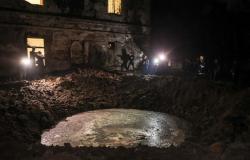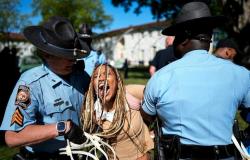The city of millions, which is known for having an incredibly punctual public transport system, delivered on the mark and tens of thousands of travelers boarded the city’s trains and subways.
On the journey with five of the city’s many different subway lines, there were also five men with them who had some unremarkable bags with them. The bags contained the deadly gas Sarin. The five men had also equipped themselves with umbrellas with pointed tips.
When the moment arrived, the men quickly punched holes in their bags and rushed out of the subway, out of the station and into waiting cars that drove off, according to Britannica.
Sarin is a man-made nerve agent first developed by the Germans in 1937, and is considered a weapon of mass destruction by the United Nations and is banned in several conventions.
The substance is a clear, colorless, tasteless liquid with no noticeable odor that easily evaporates into gas and spreads in the environment, writes the American Center for Disease Control and Prevention (CDC).
The article continues below the adThe article continues below the ad
Being exposed to Sarin can lead to, among other things, convulsions and shortness of breath and death within a few minutes.
Watch video: – The window and the wall just popped out
Panic
The bags of sarin were left on the subways after the men had pierced them and left the scene, according to the BBC. When the liquid in the bags began to evaporate, it took a short time before the gas began to affect the passengers.
Witnesses have said that they noticed the leaking packages, and that shortly afterwards they felt stinging gases in their eyes.
The article continues below the adThe article continues below the ad
The subway network also did not stop and sick passengers left the subway at every stop, as the gas was swirled up when the doors opened and several passengers rushed off. The gas spread further when the bag came into contact with clothes and shoes.
Witnesses have said that they noticed the leaking packages, and that shortly afterwards they felt stinging gases in their eyes.
The article continues below the ad
Many of the people exposed to sarin during the attack were people who came into contact with the substance while trying to help those already affected.
In total, 13 people were killed in the attack and 5,500 were injured. According to the New York Times, shortly after the attacks, a gigantic hunt was launched for the perpetrators and the people behind the attack.
In this March 20, 1995 photo, injured are treated by rescuers after the deadly gas attack near Tsukiji subway station in Tokyo. The doomsday sect Aum Shinrikyo released sarin gas in Tokyo’s subways, killing 13 people. Photo: AP Photo / Kyodo News / NTB
Doomsday prophecies
Investigation revealed after a short time that it was members of the religious sect Aum Shinrikyo, led by Shoko Asahara, who were behind the attack.
Aum was a group that emerged in Japan in the 80s that mixed beliefs from both Hinduism, Buddhism, and later various doomsday prophecies.
The sect grew in size throughout the 1980s, attracting thousands of members worldwide. In Japan, Asahara was a well-known figure who also made appearances on Japanese television programs.
The article continues below the ad
Former members of the group have said they were encouraged to buy Asahara’s bath water, hair and even blood for large sums.
In this May 9, 1995 file photo, two female followers of the doomsday sect Aum Shinrikyo look on as a group of police officers search their building in Fujinomiya, central Japan. Photo: Sadayuki Mikami / AP Photo / NTB
Executed
Over time, Aum Shinrikyo evolved to focus on doomsday prophecies, and Asahara told his followers that the end of the world was imminent. The group became more violent and, before the terrorist attack on the subway, had injured, killed and used other biological means in attacks.
The article continues below the ad
According to Asahara, the attack on the subway was a “holy attempt to lift the lost souls of this world to a higher spiritual level”, writes the BBC.
After the attack, suspicion quickly fell on Aum, despite Asahara denying that the group had anything to do with the matter. The police raided the group’s properties and found evidence of the manufacture of sarin.
Hundreds of members were arrested and put on trial, among them Aum Shinrikyo’s apocalyptic leader. 13 were sentenced to death, including Asahara, who was executed in 2018.
The article continues below the ad

File photo from 1 October 1990 shows Shoko Asahara, guru and leader of the doomsday sect Aum Shinrikyo. Photo: AFP PHOTO / JIJI PRESS / NTB
Ban imposed
Aum Shinrikyo has not disappeared in the time since the attack, but has changed its name to Aleph and was the source of a breakaway group called Hikari no Wa. Aleph and Hikari no Wa are allowed to operate as religious groups in Japan but are under strict surveillance
On the anniversary of the attacks last year, Japanese authorities imposed a six-month ban on Aleph from operating 13 of its 20 or so facilities in Japan and from accepting donations, according to Japan’s Kyodonews.
Earlier that year, it was decided to limit the group’s activities due to the risk of it committing murder and other criminal acts.
Tags: years Tokyo subway attack Aum Shinrikyo struck deadly sarin
-







